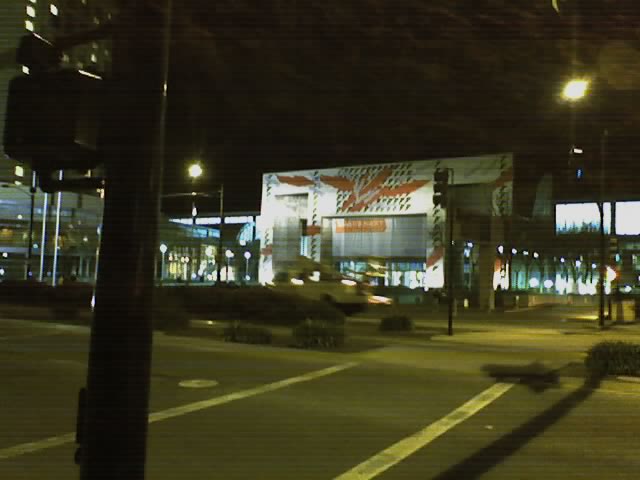Very surreal. (Peacebomb.)
The New York Times
March 24, 2006
by Daniel Terdiman
Game designers aim for Nobel Peace Prize
SAN JOSE, Calif.–Winning a Nobel Peace Prize may seem like a stretch for a video game developer, but on Thursday three leading designers attempted to show that it’s possible.
In the third-annual Game Design Challenge, put on by GameLab CEO Eric Zimmerman at the Game Developers Conference here, “Katamari Damacy” creator Keita Takahashi, Epic Games lead designer Cliff Bleszinski and “Deus Ex” lead designer Harvey Smith presented game concepts that they each believed could win the coveted peace prize.
The annual challenge–which in its two previous incarnations was won by legendary game designer Will Wright, creator of “The Sims”–isn’t about building an actual game. Rather, it is about designing a fleshed-out concept for a game that could conceivably be developed and published.
Last year, Zimmerman tasked the competitors with designing a game built on the poetry of Emily Dickinson. In 2004, the challenge was to create a game about love.
Zimmerman told the crowd that his yearly theme is based on a hot topic in the game industry. Thus, last year’s theme came from persistent buzz about game titles built on licenses of other material, such as films. The theme in 2004 came from chatter about narrative interactivity.
“The goal of the Game Design Challenge is to think about what it means to wrestle with complex game design challenges,” Zimmerman told the packed ballroom. “Why was (the Nobel Peace prize concept) selected this year? Because there is a lot of talk about serious games, those games that are not just for entertaining but for some function other than entertainment and pure fun.”
Because Wright had won the two previous years, he wasn’t a competitor this year.
“Will begged me to free him from the clutches of the Game Design Challenge, which I did,” Zimmerman said. “But until we reach the end of the session today, (he’s) still the reigning ruler.”
At that point, to tremendous laughter, Zimmerman called Wright on stage and placed a tiara on his head, then turned the floor over to the competitors.
First up was Harvey, who began his presentation by explaining that the inspiration for his concept was two game mods. One, called “Escape from Woomera,” was about the Australian government holding noncitizens prisoner. The other, about Japanese interned in the U.S. during World War II, was called “Beyond Manzanar.”
Harvey’s proposed game was based on the idea of flash mobs–a crowd of people that assembles suddenly in a public place, doing something unusual or notable, and then disperses.
He explained that in his “Peace Bomb” game concept–a multiplayer game for the Nintendo DS handheld device–play would evolve from the digital to the real world.
“The game creates flash mobs in the real world,” said Smith. “After pooling together and trading resources, players can win on a quarterly basis, or every six months or whatever, and (the) flash mob erupts around a socially constructive movement.”
He said players would have to form social networks and exchange resources virtually to work toward their goals.
Ideally, he explained, the game would spawn “cool, peaceful projects” that would “erupt all over the world,” as players move from their DS handhelds and form instant groups that plant trees, clean up public messes, build structures, donate money or collect important materials.
“There should be a U.N. resolution passed that those making the call to war must log time in this program.” –Cliff Bleszinski, lead designer, Epic Games
Ultimately, he said, the idea would spread because game play would be fun, but players would get involved initially in a bid to make a difference in their communities and around the world.
Next up was Bleszinski, whose “Empathy” concept was built around the idea that people could learn to better understand war by putting themselves in the position of the victims of military conflict.
Players would take on the role of the father of a family of five and become responsible for everyone’s well-being as war drums sound and a full-blown battle is joined.
To win, players must keep their families alive until war ends. If the family dies, then the players lose.
Bleszinksi said his fantasy was that the game would help world leaders avoid war through better understanding of the consequences of their political actions.
“There should be a U.N. resolution passed,” he said, “that those making the call to war must log time in this program.”
Last up was Takahashi. As the creator of the popular “Katamari Damacy,” the hit game of the 2005 Game Developers Conference, Takahashi was clearly a crowd favorite.
But while his presentation style was well-received and endearing, his concept was thin on game design elements. Takahashi said that because people love video games and are not violent while they play, the world could be more peaceful if everyone played video games.
After the final presentation, Zimmerman exhorted the audience of hundreds to vote with applause for their favorite.
Zimmerman and Wright ultimately judged the audience response for Smith’s “Peace Bomb” to be the loudest and declared him the winner.
Wright placed the tiara on Smith’s head and then ran off the stage waving his hands wildly.
To Zimmerman, the contest is about more than getting top designers to pit their conceptual skills against each other.
“There is no reason that any of these game designs could not be realized,” he told the crowd of designers. “I want (you to) make more games, better games and more innovative games.”
For Wright, being able to watch the event, but not participate, was relaxing. But he said he thinks the challenge is important.
“It’s inspirational,” Wright told CNET News.com, “especially since you’re allowed to think about problems that market considerations don’t allow.”
He said the challenge also brings out interesting elements of innovation.
“Not so much design innovation,” he said, “but social innovation how to reach people” with game designs that are outside the usual commercial fare.
Zimmerman also said he was happy with the results of the challenge, which he spent months producing.
“The thing about the Game Design Challenge is that it’s like game design,” Zimmerman told News.com. “I create the structure and then (the contestants) come play in it. It’s satisfying seeing players take your design and play with it.”
Information contained in this CNET News.com report may not be republished or redistributed without the prior written authority of CNET, Inc. For Permission, contact permissions@cnet.com.
Copyright 2006
NY Times article





